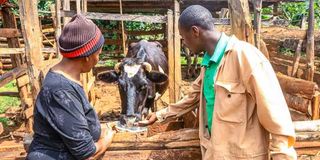Premium
Young farmer puts smile on dairy and poultry keepers

Peter Ng’ang’a, the founder of Farmer’s Smile Africa, and local farmer Isabel Wairimu feed a cow.
Peter Ng’ang’a is a man on a mission. He wants the best for dairy and poultry farmers in Nembu village, Gatundu South constituency, Kiambu County. Ng’ang’a’s quest began after his first poultry project failed. More than half the chicks he had started with died as he had little knowledge on feed.
“My background is humble. I started with about 100 chicks, but was left with just 40 after a few days,” he says.
The agribusiness started soon after Ng’ang’a had completed his secondary school education and enrolled for a six-month course on animal feed formulation at the Dairy Training Institute, Naivasha.
Ng’ang’a did not want to repeat the same mistakes he made on feeding his chicks.
After the training, Ng’ang’a founded an organisation called Farmer’s Smile Africa.
“Getting high quality feed and information was a big challenge. I also had problems with delivering products on time. That is why I came up with the idea of creating the brand. We wanted to provide quality products, information and services to farmers then make follow-ups,” he says.

Peter Ng’ang’a fills a bag with animal feed at his business premises in Gatundu South constituency.
Farmer’s Smile Africa boasts of 70 members that Ng’ang’a trains, mentors and involves in demonstrations. The members are dairy and poultry farmers.
“I help address problems farmers encounter by providing information. The organisation also works with experts. When, for instance, a farmer needs information on horticulture, I refer him or her to the appropriate experts,” he says.
mencken indent: Ng’ang’a also owns a shop that sells feed for cows, pigs and poultry. He has invested in technology that mixes the raw materials after formulating. A tonne of feed for dairy cows is made in 40 minutes only.
Farmer’s Smile Africa also links livestock owners with insurance companies.
“The animals are insured against death, diseases and accidents,” Ng’ang’a says.
Farmers in Nembu have formed groups with the purpose of sharing knowledge.
Isabel Wairimu, a dairy farmer and a member of Farmer’s Smile Africa, is the chairperson of Gathage Mwanzo Mpya Group.
“Before being trained on proper feeding, I used to call an animal health service provider regularly to give them injections. That has changed. The health of my cows has improved and their skins are smooth,” the 56-year-old says.
“The quantity of milk has more than doubled. One of my cows used to produced just five litres of milk a day. The amount has risen to 11. The younger one produces about 20 litres.”
Wairimu sells her milk to cooperative societies and individuals. She monitors her cows from birth. The farmer says the quality and quantity of milk production is determined by the age of the animal. Wairimu’s poultry project is also thriving.
“Many people come to buy eggs for hatching. It makes me happy for it shows that I’m helping other households start or improve their farming. I also grow Napier grass, bananas, avocados and other crops,” she says.
Antonio Innocent Mudong’i, an animal nutritionist, compares a dairy cow to a baby, saying production can be expensive.
“When you chop and press Napier grass, water will come out. Farmers need to note that about 80 per cent of the grass is water,” he says.
“The animal will naturally be tempted to eat such grass. The farmer should ensure the grass dries and then chop it. Give the animal three kilogrammes of the dry matter.”
Mudong’i advises farmers to harvest hay when flowering as that is the time nutrients are most concentrated. There is also a good protein level in the grass.
“Lack of knowledge by farmers leads to poor feeding. Because of that, the animal gets diarrhoeal and other opportunistic diseases,” he says.
The illnesses are also as a result of feed that is full of aflatoxin. Do not preserve the feed in an area full of moisture.”





